Student Perceptions of Learning and Instructional Effectiveness in College Courses
https://www.ets.org/Media/Products/perceptions.pdf
Students’ Perception of Gamification in Learning and Education.
https://link.springer.com/chapter/10.1007%2F978-3-319-47283-6_6
College students’ perceptions of pleasure in learning – Designing gameful gamification in education
investigate behavioral and psychological metrics that could affect learner perceptions of technology
today’s learners spend extensive time and effort posting and commenting in social media and playing video games
Creating pleasurable learning experiences for learners can improve learner engagement.
uses game-design elements in non-gaming environments with the purpose of motivating users to behave in a certain direction (Deterding et al., 2011)
How can we facilitate the gamefulness of gamification?
Most gamified activities include three basic parts: “goal-focused activity, reward mechanisms, and progress tracking” (Glover, 2013, p. 2000).
gamification works similarly to the instructional methods in education – clear learning and teaching objectives, meaningful learning activities, and assessment methods that are aligned with the objectives
the design of seven game elements:
- Storytelling: It provides the rules of the gamified activities. A good gamified activity should have a clear and simple storyboard to direct learners to achieve the goals. This game-design element works like the guidelines and directions of an instructional activity in class.
- Levels: A gamified activity usually consists of different levels for learners to advance through. At each level, learners will face different challenges. These levels and challenges can be viewed as the specific learning objectives/competencies for learners to accomplish.
- Points: Points pertain to the progress-tracking element because learners can gain points when they complete the quests.
- Leaderboard: This element provides a reward mechanism that shows which learners are leading in the gamified activities. This element is very controversial when gamification is used in educational contexts because some empirical evidence shows that a leaderboard is effective only for users who are aggressive and hardcore players (Hamari, Koivisto, & Sarsa, 2014).
- Badges: These serve as milestones to resemble the rewards that learners have achieved when they complete certain quests. This element works as the extrinsic motivation for learners (Kapp, 2012).
- Feedback: A well-designed gamification interface should provide learners with timely feedback in order to help them to stay on the right track.
- Progress: A progress-tracking bar should appear in the learner profile to remind learners of how many quests remain and how many quests they have completed.
Dominguez et al. (2013) suggested that gamification fosters high-order thinking, such as problem-solving skills, rather than factual knowledge. Critical thinking, which is commonly assessed in social science majors, is also a form of higher-order thinking.
Davis (1989) developed technology acceptance model (TAM) to help people understand how users perceive technologies. Pleasure, arousal, and dominance (PAD) emotional-state model that developed by Mehrabian (1995) is one of the fundamental design frameworks for scale development in understanding user perceptions of user-system interactions.
Van der Heijdedn (2004) asserted that pleasurable experiences encouraged users to use the system for a longer period of time
Self-determination theory (Deci & Ryan, 1985) has been integrated into the design of gamification and addressed the balance between learners’ extrinsic and intrinsic motivation.
Ryan and Deci (2000) concluded that extrinsic rewards might suppress learners’ intrinsic motivation. Exploiting the playfulness and gamefulness in gamification, therefore, becomes extremely important, as it would employ the most effective approaches to engage learners.
Sweetser and Wyeth (2005) developed GameFlow as an evaluation model to measure player enjoyment in games
Fu, Su, and Yu (2009) adapted this scale to EGameFlow in order to measure college students’ enjoyment of e-learning games. EGameFlow is a multidimensional scale that consists of self-evaluated emotions.
Eppmann, Bekk, and Klein (2018) developed gameful experience scale (GAMEX) to measure gameful experiences for gamification contexts. one of the limitations of GAMEX to be used in education is that its effects on learning outcome has not been studied
the Big Five Model, which has been proposed as trait theory by McCrae & Costa (1989) and is widely accepted in the field, to measure the linkages between the game mechanics in gamification and the influences of different personality traits.
Storytelling in the subscale of Preferences for Instruction emphasizes the rules of the gamified learning environments, such as the syllabus of the course, the rubrics for the assignments, and the directions for tasks. Storytelling in the subscale of Preferences for Instructors’ Teaching Style focuses on the ways in which instructors present the content. For example, instructors could use multimedia resources to present their instructional materials. Storytelling in the subscale of Preferences for Learning Effectiveness emphasizes scaffolding materials for the learners, such as providing background information for newly introduced topics.
The effective use of badges would include three main elements: signifier, completion logic, and rewards (Hamari & Eranti, 2011). A useful badge needs clear goal-setting and prompt feedback. Therefore, badges correlate closely with the design of storytelling (rules) and feedback, which are the key game design elements in the subscale of Preferences for Instruction.
Students can use Google to search on their laptops or tablets in class when instructors introduce new concepts. By reading the reviews and viewing the numbers of “thumbs-up” (agreements by other users), students are able to select the best answers. Today’s learners also “tweet” on social media to share educational videos and news with their classmates and instructors. Well-designed gamified learning environments could increase pleasure in learning by allowing students to use familiar computing experiences in learning environments.
Fri, Feb. 2, 2018, Principalship class, 22 people, Plymouth room 103
Instructor Jim Johnson EDAD principalship class
The many different roles of the principals:
Communication
Effective communication is one critical characteristics of effective and successful school principal. Research on effective schools and instructional leadership emphasizes the impact of principal leadership on creating safe and secure learning environment and positive nurturing school climate (Halawah, 2005, p. 334)
Halawah, I. (2005). The Relationship between Effective Communication of High School Principal and School Climate. Education, 126(2), 334-345.
http://login.libproxy.stcloudstate.edu/login?qurl=http%3a%2f%2fsearch.ebscohost.com%2flogin.aspx%3fdirect%3dtrue%26db%3deric%26AN%3dEJ765683%26site%3dehost-live%26scope%3dsite
Selection of school principals in Hong Kong. The findings confirm a four-factor set of expectations sought from applicants; these are Generic Managerial Skills; Communication and Presentation Skills; Knowledge and Experience; and Religious Value Orientation.
Kwan, P. (2012). Assessing school principal candidates: perspectives of the hiring superintendents. International Journal Of Leadership In Education, 15(3), 331-349. doi:10.1080/13603124.2011.617838
http://login.libproxy.stcloudstate.edu/login?qurl=http%3a%2f%2fsearch.ebscohost.com%2flogin.aspx%3fdirect%3dtrue%26db%3dkeh%26AN%3d77658138%26site%3dehost-live%26scope%3dsite
Yee, D. L. (2000). Images of school principals’ information and communications technology leadership. Journal of Information Technology for Teacher Education, 9(3), 287–302. https://doi.org/10.1080/14759390000200097
Catano, N., & Stronge, J. H. (2007). What do we expect of school principals? Congruence between principal evaluation and performance standards. International Journal of Leadership in Education, 10(4), 379–399. https://doi.org/10.1080/13603120701381782
Communication can consist of two large areas:
- broadcasting information: PR, promotions, notifications etc.
- two-way communication: collecting feedback, “office hours” type of communication, backchanneling, etc.
Further communication initiated by/from principals can have different audiences
- staff: teachers, maintenance etc.
Ärlestig, H. (2008). Communication between principals and teachers in successful schools. DIVA. Retrieved from http://urn.kb.se/resolve?urn=urn:nbn:se:umu:diva-1927
Reyes, P., & Hoyle, D. (1992). Teachers’ Satisfaction With Principals’ Communication. The Journal of Educational Research, 85(3), 163–168. https://doi.org/10.1080/00220671.1992.9944433
- parents: involvement, feeling of empowerment, support, volunteering
- students
- board members
- community
Epstein, J. L. (1995). School/family/community partnerships – ProQuest. Phi Delta Kappan, 76(9), 701.
Communication and Visualization
The ever-growing necessity to be able to communicate data to different audiences in digestible format.
https://blog.stcloudstate.edu/ims/2017/07/15/large-scale-visualization/
So, how do we organize and exercise communication with these audiences and considering the different content to be communicated?
- How do you use to do it at your school, when you were students 20-30 years ago?
- How is it different now?
- How do you think it must be changed?
Communication tools:
physical
- paper-based memos, physical boards
Electronic
- phone, Intercom, email, electronic boards (listservs)
21st century electronic tools
- Electronic boards
- Internet telephony and desktopsharing
- Adobe Connect, Webex, Zoom, GoToMeeting, Teamviewer etc.
- Skype, Google Hangouts, Facebook Messenger
- Electronic calendars
- Doodle, MS Offce365, Google Calendar
- Social media / The Cloud
- Visuals: Flickr, YouTube, TeacherTube, MediaSpace
- Podasts
- Direct two-way communication
- Asynchronous
- Snapchat
- Facebook
- Twitter
- LinkedIn
- Instagram
- Synchronous
- Chat
- Audio/video/desktopsharing
- Management tools
Tools:
https://blog.stcloudstate.edu/ims/2016/07/16/communication-tool-for-teachers-and-parents/
Top 10 Social Media Management Tools: beyond Hootsuite and TweetDeck
https://blog.stcloudstate.edu/ims/2013/11/17/top-10-social-media-management-tools-beyond-hootsuite-and-tweetdeck/
Manage control of your passwords and logons (Password Managers)
- 1Password.
- Okta.
- Keeper.
- KeePass.
- Centrify Application Services.
- RoboForm.
- Zoho Vault.
- Passpack.
- LastPass
+++++++++++++++++++++
class discussion Feb 2.
PeachJar : https://www.peachjar.com/
Seesaw: https://web.seesaw.me/
Schoology: https://www.schoology.com/
++++++++++++++++++++++
Group Assignment
considering the information discussed in class, split in groups of 4 and develop your institution strategy for effective and modern communication across and out of your school.
>>>>>>>>>>> Word of the day: blockchain credentialing <<<<<<<<<<<<<<<<<<<<<
>>>>>>>>>>> K12 Trends 4 2018 <<<<<<<<<<<<<<<<<
doctoral cohort student’s request for literature: “I am looking for some more resources around the historical context of teacher evaluation.”
pre-existing bibliography:
Allen, J., Gregory, A., Mikami, A. I., Lun, J., Hamre, B., & Pianta, R. (2013). Observations of Effective Teacher-Student Interactions in Secondary School Classrooms: Predicting Student Achievement With the Classroom Assessment Scoring System—Secondary. School Psychology Review, 42(1), 76–98.
Alonzo, A. C. (2011). COMMENTARIES Learning Progressions That Support Formative Assessment Practices. Measurement, 9, 124–129. http://doi.org/10.1080/15366367.2011.599629
Baker, B. D., Oluwole, J. O., & Green, P. C. (2013). The Legal Consequences of Mandating High Stakes Decisions Based on Low Quality Information: Teacher Evaluation in the Race-to-the-Top Era. Education Policy Analysis Archives, 21(5), 1–71. http://doi.org/http://epaa.asu.edu/ojs/article/view/1298
Benedict, A. E., Thomas, R. a., Kimerling, J., & Leko, C. (2013). Trends in Teacher Evaluation. Teaching Exceptional Children. May/Jun2013, 45(5), 60–68.
Bonavitacola, A. C., Guerrazzi, E., & Hanfelt, P. (2014). TEACHERS’ PERCEPTIONS OF THE IMPACT OF THE McREL TEACHER EVALUATION SYSTEM ON PROFESSIONAL GROWTH.
Charlotte Danielson. (2016). Creating Communities of Practice. Educational Leadership, (May), 18 – 23.
Darling-Hammond, L., Wise, A. E., & Pease, S. R. (1983). Teacher Evaluation in the Organizational Context: A Review of the Literature. Review of Educational Research, 53(3), 285–328. http://doi.org/10.3102/00346543053003285
Darling-Hammond, L., Jaquith, A., & Hamilton, M. (n.d.). Creating a Comprehensive System for Evaluating and Supporting Effective Teaching.
Derrington, M. L. (n.d.). Changes in Teacher Evaluation: Implications for the Principal’s Work.
Gallagher, H. A. (2004). Vaughn Elementary’s Innovative Teacher Evaluation System: Are Teacher Evaluation Scores Related to Growth in Student Achievement? Peabody Journal of Education, 79(4), 79–107. http://doi.org/10.1207/s15327930pje7904_5
Hallgren, K., James-Burdumy, S., & Perez-Johnson, I. (2014). STATE REQUIREMENTS FOR TEACHER EVALUATION POLICIES PROMOTED BY RACE TO THE TOP.
Hattie Helen E-Mail Address, J. T., Hattie, J., & Timperley, H. (2007). The power of feedback. [References]. Review of Educational Research, .77(1), 16–7. http://doi.org/10.3102/003465430298487
Hazi, H. M. (n.d.). Legal Challenges to Teacher Evaluation: Pitfalls and Possibilities in the States. http://doi.org/10.1080/00098655.2014.891898
Ingle, W. K., Willis, C., & Fritz, J. (2014). Collective Bargaining Agreement Provisions in the Wake of Ohio Teacher Evaluation System Legislation. Educational Policy. http://doi.org/10.1177/0895904814559249
Marzano, R. J. (2012). The Two Purposes of Teacher Evaluation. Educational Leadership, 70(3), 14–19. Retrieved from http://search.ebscohost.com/login.aspx?direct=true&db=aph&AN=83173912&site=ehost-live
Moskal, A. C. M., Stein, S. J., & Golding, C. (2016). Assessment & Evaluation in Higher Education Can you increase teacher engagement with evaluation simply by improving the evaluation system? Can you increase teacher engagement with evaluation simply by improving the evaluation system? http://doi.org/10.1080/02602938.2015.1007838
Quinn, A. E. (n.d.). The Delta Kappa Gamma Bulletin Looking a t th e B igger Picture w ith Dr. R o b ert M arzan o : Teacher E valuation and D e v e lo p m e n t fo r Im p ro ved S tu d en t Learning.
Riordan, J., Lacireno-Paquet, Shakman, N., Bocala, K., & Chang, C. (2015). Redesigning teacher evaluation: Lessons from a pilot implementation. Retrieved from http://ies.ed.gov/
Taylor, E. S., & Tyler, J. H. (n.d.). Evidence of systematic growth in the effectiveness of midcareer teachers Can Teacher Evaluation Improve Teaching?
Tuytens, M., & Devos, G. (n.d.). The problematic implementation of teacher evaluation policy: School failure or governmental pitfall? http://doi.org/10.1177/1741143213502188
Wong, W. Y., & Moni, K. (2013). Teachers’ perceptions of and responses to student evaluation of teaching: purposes and uses in clinical education. http://doi.org/10.1080/02602938.2013.844222
my list of literature:
Avalos, B., & Assael, J. (2006). Moving from resistance to agreement: The case of the Chilean teacher performance evaluation. International Journal of Educational Research, 45(4-5), 254-266.
Cowen, J. M., & Fowles, J. (2013). Same contract, different day? an analysis of teacher bargaining agreements in Louisville since 1979. Teachers College Record, 115(5)
Flippo, R. F. (2002). Repeating history: Teacher licensure testing in Massachusetts. Journal of Personnel Evaluation in Education, 16(3), 211-29.
Griffin, G. (1997). Teaching as a gendered experience. Journal of Teacher Education, 48(1), 7-18.
Hellawell, D. E. (1992). Structural changes in education in England. International Journal of Educational Reform, 1(4), 356-65.
Hibler, D. W., & Snyder, J. A. (2015). Teaching matters: Observations on teacher evaluations. Schools: Studies in Education, 12(1), 33-47.
Hill, H. C., & Grossman, P. (2013). Learning from teacher observations: Challenges and opportunities posed by new teacher evaluation systems. Harvard Educational Review, 83(2), 371-384.
Hines, L. M. (2007). Return of the thought police?: The history of teacher attitude adjustment. Education Next, 7(2), 58-65.
Kersten, T. A. (2006). Teacher tenure: Illinois school board presidents’ perspectives and suggestions for improvement. Planning and Changing, 37(3-4), 234-257.
Kersten, T. A., & Israel, M. S. (2005). Teacher evaluation: Principals’ insights and suggestions for improvement. Planning and Changing, 36(1-2), 47-67.
Korkmaz, I. (2008). Evaluation of teachers for restructured elementary curriculum (grades 1 to 5). Education, 129(2), 250-258.
Lamb, M. L., & Swick, K. J. (1975). Historical overview of teacher observation Educational Forum.
Maharaj, S. (2014). Administrators’ views on teacher evaluation: Examining Ontario’s teacher performance appraisal. Canadian Journal of Educational Administration and Policy, (152)
Naba’h, A. A., Al-Omari, H., Ihmeideh, F., & Al-Wa’ily, S. (2009). Teacher education programs in Jordan: A reform plan. Journal of Early Childhood Teacher Education, 30(3), 272-284.
Ornstein, A. C. (1977). Critics and criticism of education Educational Forum.
Pajak, E., & Arrington, A. (2004). Empowering a profession: Rethinking the roles of administrative evaluation and instructional supervision in improving teacher quality. Yearbook of the National Society for the Study of Education, 103(1), 228-252.
Stamelos, G., & Bartzakli, M. (2013). The effect of a primary school teachers, trade union on the formation and realisation of policy in Greece: The case of teacher evaluation policy. Policy Futures in Education, 11(5), 575-588.
Stamelos, G., Vassilopoulos, A., & Bartzakli, M. (2012). Understanding the difficulties of implementation of a teachers’ evaluation system in greek primary education: From national past to european influences. European Educational Research Journal, 11(4), 545-557.
Sullivan, J. P. (2012). A collaborative effort: Peer review and the history of teacher evaluations in Montgomery county, Maryland. Harvard Educational Review, 82(1), 142-152.
Tierney, W. G., & Lechuga, V. M. (2005). Academic freedom in the 21st century. Thought & Action, , 7-22.
Turri, M. (2014). The new italian agency for the evaluation of the university system (ANVUR): A need for governance or legitimacy? Quality in Higher Education, 20(1), 64-82.
VanPatten, J. J. (1972). Some reflections on accountability Journal of Thought.
Vijaysimha, I. (2013). Teachers as professionals: Accountable and autonomous? review of the report of the justice Verma commission on teacher education. august 2012. department of school education and literacy, ministry of human resource development, government of India. Contemporary Education Dialogue, 10(2), 293-299.
Vold, D. J. (1985). The roots of teacher testing in America. Educational Measurement: Issues and Practice, 4(3), 5-7.
Wermke, W., & Höstfält, G. (2014). Contextualizing teacher autonomy in time and space: A model for comparing various forms of governing the teaching profession. Journal of Curriculum Studies, 46(1), 58-80.
Ydesen, C., & Andreasen, K. E. (2014). Accountability practices in the history of Danish primary public education from the 1660s to the present. Education Policy Analysis Archives, 22(120)
Link to the archived session:
http://www.nrocnetwork.org/professional-development/webinar
“Colorado’s Digital Badging Initiative: A New Model of Credentialing Technical Math Skills and More”.
Educators and innovative industry leaders agree that digital badges are evolving into a key credential that can be used to meet current education and workforce needs. As part of its TAACCCT grant, the Colorado Community College System is leading a collaborative effort to develop micro-credentials or digital badges to serve post-secondary and workforce in partnership. Learn about early pilot uses of digital badges in technical math and advanced manufacturing, as well as plans for the future. The presenter will also share perspectives garnered from her participation in the Badge Alliance/OPEN badges workgroup that is shaping the national conversation on this emerging topic.
Presenter: Brenda Perea, Instructional Design Project Manager, Colorado Community College System
Plan to log on 15 MINUTES BEFORE THE HOUR so you will be up and running before the webinar begins. (It may take a few minutes to download the software to your computer.)
We will begin the webinar promptly at 2:00 PM ET (1 CT/12 MT/11 PT) on Thursday, June 23.
Please send your questions, comments and feedback to: memberservices@theNROCproject.org
How To Join The Webinar
Thu, Jun 23, 2016 1:00 PM – 2:00 PM CDT
Add to Calendar: Outlook® Calendar | Google Calendar™ | iCal®
1. Click the link to join the webinar at the specified time and date:
https://global.gotowebinar.com/join/7204276536935317252/397462206
Before joining, be sure to check system requirements to avoid any connection issues.
Note: This link should not be shared with others; it is unique to you.
2. Choose one of the following audio options:
TO USE YOUR COMPUTER’S AUDIO:
When the webinar begins, you will be connected to audio using your computer’s microphone and speakers (VoIP). A headset is recommended.
–OR–
TO USE YOUR TELEPHONE:
If you prefer to use your phone, you must select “Use Telephone” after joining the webinar and call in using the numbers below.
United States: +1 (914) 614-3221
Access Code: 330-025-475
Audio PIN: Shown after joining the webinar
Webinar ID: 148-791-923
If you are new to GoToWebinar, we suggest that you click the link below and run the GoToWebinar configuration test to ensure your computer is ready to access this online meeting environment.
http://tinyurl.com/GTWtest
If you are using older operating systems, you may need to use GTW web access rather than the desktop application and possibly phone in for audio. See http://bit.ly/1VVCeno for more info.
If you experience problems entering the GoToWebinar room, or with the online tools during the session, please send an email to memberservices@thenrocproject.org.
This webinar will be archived in the “Professional Development” area of the NROC Network at http://www.nrocnetwork.org/professional-development/webinar.
We look forward to your participation.
Sincerely
The NROC Team
webinar
http://www.nrocnetwork.org/colorados-digital-badging-initiative-new-model-credentialing-technical-math-skills-and-more
badges are integrated with the industry partners of the educational institution
how to determine the value of a badge.
Faculty writing a competencies, online and blended environment. All agree that this means competency. Need to faculty buy in, if issuing badges. Objective versus subjective measures. Faculty member is the one who tells students how to earn badges. Not punitive, but a reward.
building the eco system in Colorado. But it can be taken on a national level. Employers in other states to accept. MS, Sisco are issuing badges, which will be internationally.
how does it fit in the bigger picture of credentials. Lumina Foundations. Next project. https://www.luminafoundation.org/
MOOC (Canvas)
Microsoft badging system. https://education.microsoft.com/ViewAll/Badges
brenda.perea@cccs.edu
NROCnetwork.org http://nrocnetwork.org/
badges are transferable. not person to person, but repository
of 200 issues badges, they were shared 6K+ times over social media: LinkedIn, FB etc. by employers.
backpack, or stored in Mozilla backpack. Most of LMS developing badging capabilities.
some LMS want to create their own badging, gatekeep in LMS, but losing
Canvas allows any badging
LCI in any LMS. LMS allow the vehicle to be issued, but does not create it.

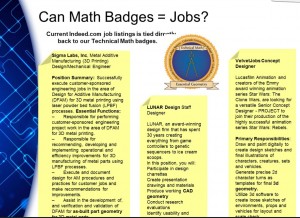



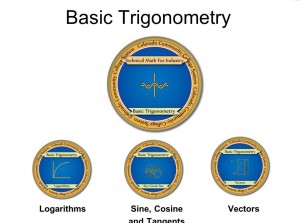

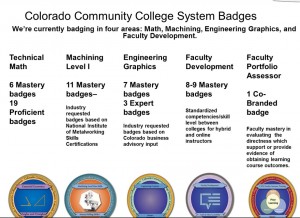
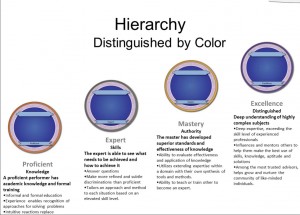
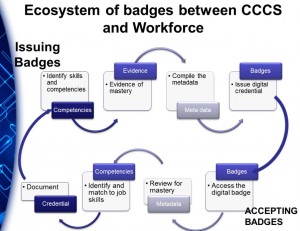
Join us next Tuesday, November 10th from 12:00 PM to 1:00 PM, for a special SIG Series webinar: Tales from the National Forum on Active Learning Classrooms
The WSU Learning Spaces Team attended the National Forum on Active Learning Classrooms at the University of Minnesota – Twin Cities this summer and learned a lot. With topics ranging from picking whiteboards to better integrating classroom design into your campus strategic planning efforts, the conference was a treasure trove of good practices, pictures of cool new classrooms, links to useful information, and pro tips. Join us as we share what we learned at this amazing gathering. If you didn’t get a chance to go, this session will be a great opportunity to zoom in on the highlights. If you went, we would love to compare notes!
Ken Graetz, Tom Hill, Stephanie Stango, Dave Burman, and Eric Wright are all part of the Winona State University Learning Spaces Team and members of the Teaching, Learning, and Technology Services unit of Information Technology Services. They attended the National Forum as a team this summer and were able to cover almost all of the sessions. Each brings a unique perspective to the discussion, from under-the-hood classroom systems design and configuration to instructional design and pedagogical strategies.
Register for the webinar at http://www.eventbrite.com/o/minnesota-online-quality-initiative-7290950883. Please forward this on to anyone on your campus who might be interested.
Link to the Virtual Room:
https://moqi.zoom.us/j/672493176
Or join by phone:
+1 646 568 7788 (US Toll) or +1 415 762 9988 (US Toll)
Meeting ID: 672 493 176
FlexSpace. flexspace.org
CCUMC Leadership in Media and Academic Technology. http://www.ccumc.org
EduCause learning space rating system.
http://www.educause.edu/eli/initiatives/learning-space-rating-system
McGill Principles for Designing of Teaching and Learning Spaces has rubric
most useful technology in an ALC appears to be the whiteboard.
Whiteboards are also very glitchy. Projecting my tablet or laptop is just as effective–with less glitches
evidence that students are reluctant to engage in active learning.
the U has done work, but the “Canadians have the process”
the support faculty gets from technicians: two week in the beginning of the semester in a new classroom.
what is the most important goal of your college education and therefore of this course: a. inquiring information b. learning how to sue information and knowledge in anew situation c. developing skills to continue learning after college
- creativity
- computer skills
- GPA cutoff above 3.0
- problem solving skills
- teamwork skills
- verbal communication
- written communication skills
GigaPan.com instructor will have students use in classes to identify problems engaging in a virtual field trip. student engagement
design thinking
wikispaces as GOogle docs, MS Word 16, work collaboratively
not group, but team. team work very important
take what we learned in ALCs to traditional large lecture halls
blending the formal with the informal (including outdoors)
connecting ALCs together across distance
thinking about gear (raised floors, smart kapp boards) http://smartkapp.com/
 About the Presenter
About the Presenter







